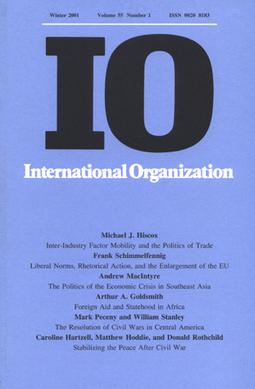Related Research Articles
College and university rankings order institutions in higher education based on factors that vary depending on the ranking. Some rankings evaluate institutions within a single country, while others assess institutions worldwide. Rankings are typically conducted by magazines, newspapers, websites, governments, or academics. In addition to ranking entire institutions, specific programs, departments, and schools can be ranked. Some rankings consider measures of wealth, excellence in research, selective admissions, and alumni success. Rankings may also consider various combinations of measures of specialization expertise, student options, award numbers, internationalization, graduate employment, industrial linkage, historical reputation and other criteria.

International Organization is a quarterly peer-reviewed academic journal that covers the entire field of international affairs. It was established in 1947 and is published by Cambridge University Press on behalf of the International Organization Foundation. The editors-in-chief are Brett Ashley Leeds and Layna Mosley.
Alexander Wendt is an American political scientist who is one of the core social constructivist researchers in the field of international relations, and a key contributor to quantum social science. Wendt and academics such as Nicholas Onuf, Peter J. Katzenstein, Emanuel Adler, Michael Barnett, Kathryn Sikkink, John Ruggie, Martha Finnemore, and others have, within a relatively short period, established constructivism as one of the major schools of thought in the field.

The School of International Service (SIS) is American University's school of advanced international study, covering areas such as international politics, international communication, international development, international economics, peace and conflict resolution, international law and human rights, global environmental politics, and U.S. foreign policy.

The School of International and Public Affairs (SIPA) is the international affairs and public policy school of Columbia University, a private Ivy League university located in Morningside Heights, Manhattan, New York City. SIPA offers Master of International Affairs (MIA) and Master of Public Administration (MPA) degrees in a range of fields, as well as the Executive MPA and PhD program in Sustainable Development.

International Security is a peer-reviewed academic journal in the field of international and national security. It was founded in 1976 and is edited by the Belfer Center for Science and International Affairs at Harvard University and published four times a year by MIT Press, both of Cambridge, Massachusetts. The current editor-in-chief is Steven E. Miller of Harvard University.
A Master in International Affairs (MIA), Master in Global Affairs (MGA), Master of Arts in International Relations (MAIR), Master of International Policy and Practice (MIPP), or Master of Science in Foreign Service (MSFS) is a professional master's degree in international affairs.

The Elliott School of International Affairs is the professional school of international relations, foreign policy, and international development of the George Washington University, in Washington, D.C. It is highly ranked in international affairs and is the largest school of international relations in the United States.
Michael Nathan Barnett is a professor of international relations at George Washington University's Elliott School of International Affairs. Known for his Constructivist approach, his scholarship and research has been in the areas of international organizations, international relations theory, and Middle Eastern politics.

World Politics is a quarterly peer-reviewed academic journal covering political science and international relations. It is published by Johns Hopkins University Press on behalf of the Princeton Institute for International and Regional Studies. Before 2003, it was sponsored by Princeton's Center of International Studies and before 1951, by the Yale Institute of International Studies. It was established in 1948. The chair of the editorial committee is Grigore Pop-Eleches.

The Graduate Institute of International and Development Studies, also known as the Geneva Graduate Institute, is a public-private graduate-level university located in Geneva, Switzerland.

The University of Sydney Business School is the business school and a constituent body of the University of Sydney. It was established in January 2011 and formed from the School of Business within the previous Faculty of Economics and Business. The former combined faculty itself descended from the original Faculty of Economics founded in 1920, which was the first faculty of its kind in Australia.
The Josef Korbel School of International Studies at the University of Denver is a professional school of international affairs offering undergraduate, graduate, and doctoral degrees. It is named in honor of the founding dean, Josef Korbel, father of former U.S. Secretary of State Madeleine Albright.
Martha Finnemore is an American constructivist scholar of international relations, and University Professor at the Elliott School of International Affairs at George Washington University. She is considered among the most influential international relations scholars. Her scholarship has highlighted the role of norms and culture in international politics, as well as shown that international organizations are consequential and purposive social agents in world politics that can shape state interests.
The QS World University Rankings is a portfolio of comparative college and university rankings compiled by Quacquarelli Symonds, a higher education analytics firm. Its first and earliest edition was published in collaboration with Times Higher Education (THE) magazine as Times Higher Education–QS World University Rankings, inaugurated in 2004 to provide an independent source of comparative data about university performance. In 2009, the two organizations parted ways to produce independent university rankings, the QS World University Rankings and THE World University Rankings.
The School ofJournalism & Mass Communication (UWSJMC) is the journalism school of the University of Wisconsin–Madison. Located in Vilas Communication Hall, the School offers two undergraduate programs, two Master of Arts programs in Journalism, and a doctoral program.
Rankings of universities in Canada are typically published annually by a variety of nationally, and internationally based publications. Rankings of post-secondary institutions have most often been conducted by magazines, newspapers, websites, governments, or academia. Ranking are established to help inform potential applicants about universities in Canada based on a range of criteria, including student body characteristics, classes, faculty, finances, library, and reputation. Various rankings consider combinations of factors, including funding and endowment, research excellence and/or influence, specialization expertise, admissions, student options, award numbers, internationalization, graduate employment, industrial linkage, historical reputation and other criteria. Various rankings also evaluate universities based on research output.
The Frederick S. Pardee School of Global Studies is the international relations and public policy school of Boston University. It was officially established in 2014 by consolidating and renaming a number of long-established programs in international and regional studies at Boston University dating back to 1953. The current dean of the Pardee School is Scott D. Taylor, an American scholar of African politics and political economy, with a particular focus on business-state relations, private sector development, governance, and political and economic reform. The Pardee School has nearly 1,000 students, including about 800 undergraduate students. It offers six graduate degrees, two graduate certificates, five undergraduate majors, and seven undergraduate minors, and also brings together seven centers and programs of regional and thematic studies.

The Department of Politics and International Studies at the University of Cambridge is the department at the University of Cambridge responsible for research and instruction in political science, international relations and public policy. It is part of the Faculty of Human, Social, and Political Science.
References
- ↑ "Faculty Survey". TRIP. 2014. Retrieved 2017-12-20.
- ↑ Peterson, Susan; Maliniak, Dan; Tierney, Michael. "Inside the Ivory Tower". Foreign Policy.
- ↑ "Academic Publications". Institute for the Theory and Practice of International Relations, TRIP. College of William & Mary. Retrieved 12 December 2017.
- ↑ Daniel Maliniak; Amy Oakes; Susan Peterson; Michael J. Tierney (March–April 2009). "Inside the Ivory Tower". Foreign Policy . The Slate Group . Retrieved 20 December 2017.
- ↑ "The Best International Relations Schools in the World". Foreign Policy. Retrieved 2018-06-12.
- ↑ "The Best International Relations Schools in the World".
- ↑ "One Discipline or Many? TRIP Survey of International Relations Faculty in Ten Countries" (PDF). Teaching, Research, and International Policy (TRIP) Project - The Institute for the Theory and Practice of International Relations. College of William & Mary. Retrieved 10 November 2017.
- ↑ "Inside the Ivory Tower". Foreign Policy. Foreign Policy magazine and the College of William & Mary. Retrieved 20 December 2017.
- ↑ "Inside the Ivory Tower (2005)" (PDF). Foreign Policy. Foreign Policy magazine and the College of William & Mary. Archived from 2005 the original on 16 March 2013. Retrieved 10 November 2012.
{{cite web}}: Check|url=value (help)